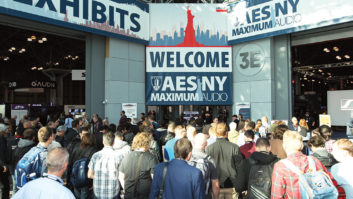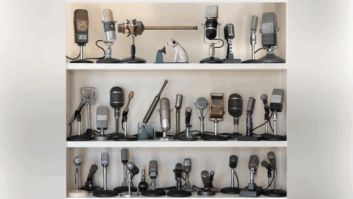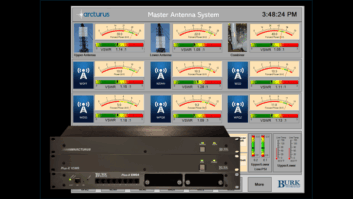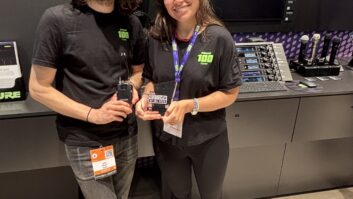Papers Delve Into DRM, Low-Profile AM Antennas, Frequency Coordination and Multichannel FM Systems
Radio World asked several of our contributors to attend various sessions at the NAB2003 convention. Here, Michael LeClair summarizes the presentations at the Radio Transmission Forum of the Broadcast Engineering Conference. Other sessions will be summarized in upcoming issues.
A Case Study in Event Coordination: 2002 Olympic Winter Games – Although broadcast engineers have to handle frequency coordination on a regular basis, the Olympic Winter Games are in a category by themselves.
A huge media event, the games involve participants from 85 countries and 5,000 athletes and officials, with more than 10,000 people involved in broadcasting to the world.
“And in my case, it was a full-time job for two years,” said Mario Hieb, radio systems frequency manager for the Winter 2002 Olympic Games.
Hieb presented an overview of how he coordinated both local and temporary users of RF spectrum.
Four basic steps were involved: handling applications for RF spectrum use, acquiring and assigning spectrum, certifying all RF equipment and enforcing the allocations during the event.
To handle the enormous number of users, a Web site was established to allow online applications for spectrum. More than 1,900 frequency applications were handled electronically, eliminating volumes of paperwork ordinarily associated with this task.
The FCC provided special temporary authorities for use during the games, providing additional spectrum. In order to leverage available frequencies further, Longley-Rice propagation studies were undertaken to measure the blocking effects of terrain, allowing multiple users where the mountain ranges blocked interference. Temporary spectrum was acquired from various government services that were not using reserved spectrum in that area.
After assigning more than 1,400 frequencies, all radio devices were required to be certified and marked with tags indicating allowable venues for operation. RF rehearsals before the games started helped to determine if the allocation plan would work. Finally, the FCC performed frequency spectrum sweeps before the games began to ensure that unlicensed users were off the air.
Hieb, who also contributes to Radio World, noted many lessons learned. He suggested that in the future, “better licensing procedures for large events” should be developed by the FCC. Additionally, he stated that “the radio devices themselves, wireless microphones in particular, are going to have to become more spectrally efficient,” as events grow larger and spectrum becomes more crowded.
Seattle’s KKOL Goes Maritime Mobile – When station KKOL(AM) was forced to leave its transmitter site of 65 years, it ended up in a unique situation. Although it had received permission to build a new 50 kW facility south of Seattle, it needed a temporary site to broadcast until the site was ready. So it moved out to sea – on a boat.
“I believe this is the only legally operating station in the United States that’s operating shipboard,” said James A. Dalke, CPBE, a contractor for Salem Communications on the project.
KKOL had to move because the Port of Seattle needed to expand container facilities on Harbor Island, a man-made island just south of Seattle. By the time an agreement to move the station was finalized, only six months remained, not enough time to build a high-power directional AM. KKOL would have to find a temporary location or go dark for an indeterminate period of time.
Several alternative sites were explored in the harbor area, including a skirted smokestack, but all fell through due to considerations of potential interference to nearby industrial users. Dalke came up with the idea of mounting an antenna on a boat that could be parked in the harbor, providing coverage to downtown Seattle. He explored the idea with Valcom, a manufacturer of physically short medium-wave antennas.
Dalke located an old fishing boat, the Coastal Ranger, with two large generators (250 kW each), and found a 300-foot pier for transient boats that had 480 V power panels. Already on board were step-down transformers to convert to 120/240V service.
“To house the transmitter, I thought about putting it inside the boat somewhere, but … I actually bought a 20-foot cargo container, modified it slightly … and there was a place to mount that on the stern of the boat,” Dalke said.
The performance of the new transmitter site turned out better than expected. Although a complete proof was not done, measurements in the harbor area showed excellent coverage in downtown Seattle, particularly along the harbor area.
Improving AM Reception with Digital Transmission – Herbert P. Jacobson, senior design engineer at HCJB Engineering, presented test results of a digital system for medium-wave transmission. He played actual off-the-air recordings of the Digital Radio Mondiale system.
DRM, is designed for European use and can operate on medium wave up to 30 MHz.
Tests of DRM in Europe were conducted between transmission facilities in England, Germany, Spain and Norway. Paths longer than 1,000 miles were tested on shortwave and standard broadcast frequencies, comparable to AM broadcast band in the United States.
Jacobson first played a recording of the standard transmission, followed by an audio sample of the digital transmission, recorded at the same time. While many of the audio samples using analog modulation were unlistenable due to interference, the digital samples all achieved good audio quality with no interference.
Jacobson additionally demonstrated reception of DRM over a 6,000-mile shortwave path from Europe to the Caribbean with good fidelity.
Testing and Results of a New Efficient Low-Profile AM Medium-Frequency Antenna System – A new approach to AM transmission was presented by Michael W. Jacobs, manager of research and development for the Star-H Corp.
Jacobs explained the principles behind the design of a reduced-height AM antenna for standard broadcast service.
“A principle of antennas is the gain-volume-bandwidth product, which is to say that if you want to have high gain and wide bandwidth, you need to have a large-volume antenna. If you are going to try to make a smaller, more compact antenna, you can only do so by compromising on the gain, the bandwidth or both,” Jacobs said.
The Star-H concept for a reduced-height antenna preserves the volume of the radiator by using a caged monopole design.
“I like to say that it’s essentially taking a monopole tower and peeling the legs down, like you’d peel the skin of a banana,” Jacobs said. To keep the antenna impedance high, multiple driven elements are used in parallel.
To prove that the concept works, both a standard quarter-wave monopole antenna and a reduced height (45-foot) caged monopole were constructed on 1680 kHz in cooperation with Kintronic Laboratories. Jacobs showed photographs of the construction of the caged monopole in detail.
Signal strengths for both antennas were measured by an outside consultant, Don Crane, and analyzed by Ron Rackley of du Treil, Lundin and Rackley, consulting engineers. The results showed the efficiency of the caged monopole as nearly equal to that of the standard antenna, around 99 percent.
Jacobs said Star-H has done modeling for the use of a caged monopole in a directional array.
“We’re very certain we can implement this in a directional pattern,” said Jacobs.
Care and Feeding of FM Multichannel Antennas – Installation and maintenance of master antenna systems was the topic of a paper presented by William Kerkhoff of Dielectric Communications. He reviewed basic master antenna system designs, construction and long-term maintenance considerations.
According to Kerkhoff, the most important aspect of master antenna performance is the installation of the antenna on the tower. Often it is not possible to pre-assemble a master antenna at the factory, and final installation is done by a tower company that may not have experience with master antennas. In particular, the proper grounding and support of the semi-rigid harness lines are essential to ensure long antenna life and good performance.
“Quality field installation is critical to long-term performance,” said Kerkhoff.
He recommended that the antenna installer and buyer visit the factory to review installation requirements and clarify expectations on the amount of time required. Photographs documenting actual installation should be taken and shared with the antenna manufacturer for review.
System testing of the master antenna should be made while the installer is on site so that adjustments can be made if necessary.
Once performance is satisfactory, a full set of measurements should be retained as a reference for troubleshooting antenna problems later.
Kerkhoff also recommended annual maintenance of master antenna systems, consisting of photos and a full set of system measurements.
Advanced Modulation System – An anticipated paper on a proposed Advanced Modulation System by Mike Dorrough was not presented. Apparently Dorrough was held back by legal considerations.
According to Andy Laird, vice president of radio engineering for Journal Broadcast Group and moderator of the forum, “Mike Dorrough … will not be presenting. He looks forward to presenting his Advanced Modulation System at a future date, but on advice from his counsel involving progress on patent applications that he has going, he can not speak to us today.”






